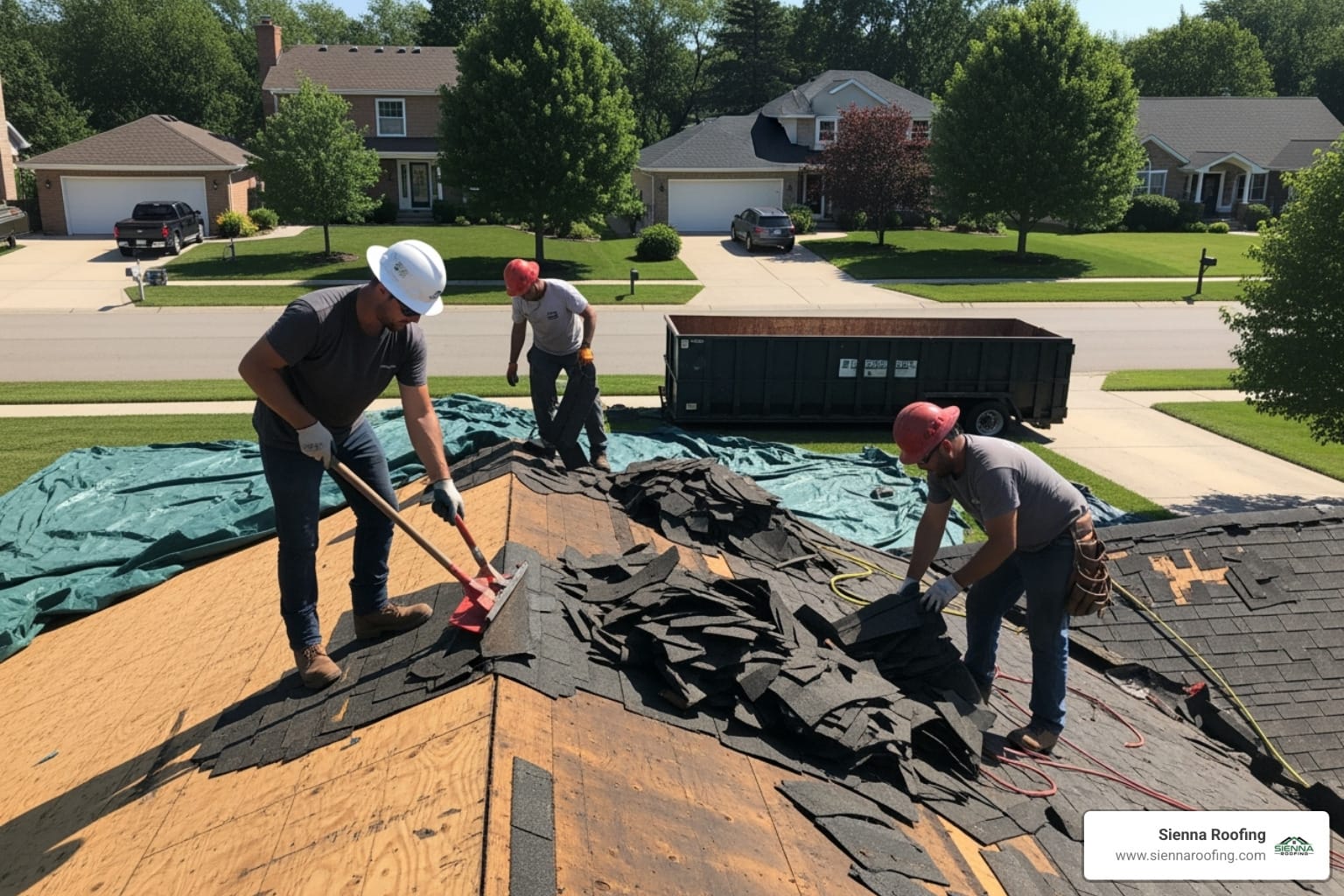Roof tear off cost: Uncover 2025’s True Value
Why Understanding Roof Tear-Off Costs Matters for Texas Homeowners
The
Roof tear off cost is one of the biggest concerns for homeowners facing a roof replacement. The numbers can feel overwhelming, but understanding the investment is the first step toward a secure, long-lasting solution. As a leading Sugar Land roofing company, we know that a full tear-off, while more intensive than an overlay, is often the best way to protect your home for decades to come.
Here’s what you need to know about roof tear-off pricing:
- Average total cost: $5,700 to $16,000 for most homes
- Cost per square foot: $3 to $6 for complete tear-off and replacement
- Tear-off labor alone: $1 to $3 per square foot
- Additional costs: Permits ($100-$500), disposal fees, potential decking repairs
The wide price range depends on your roof size, material choice, and local labor rates. While an overlay might seem cheaper upfront, a full tear-off typically lasts 20-30 years compared to just 16 years for an overlay.
Labor makes up 50-60% of your total project cost, making contractor selection crucial. In Texas, where weather extremes test every roof, understanding these costs helps you budget for quality work that protects your biggest investment. Getting multiple estimates helps you compare not just prices, but the scope of work included.
As Andre Castro, CEO of Sienna Roofing with over five years in the roofing industry, I’ve helped countless Sugar Land homeowners steer roof tear off cost decisions. My construction management background ensures every project delivers long-term value through proper planning and execution.
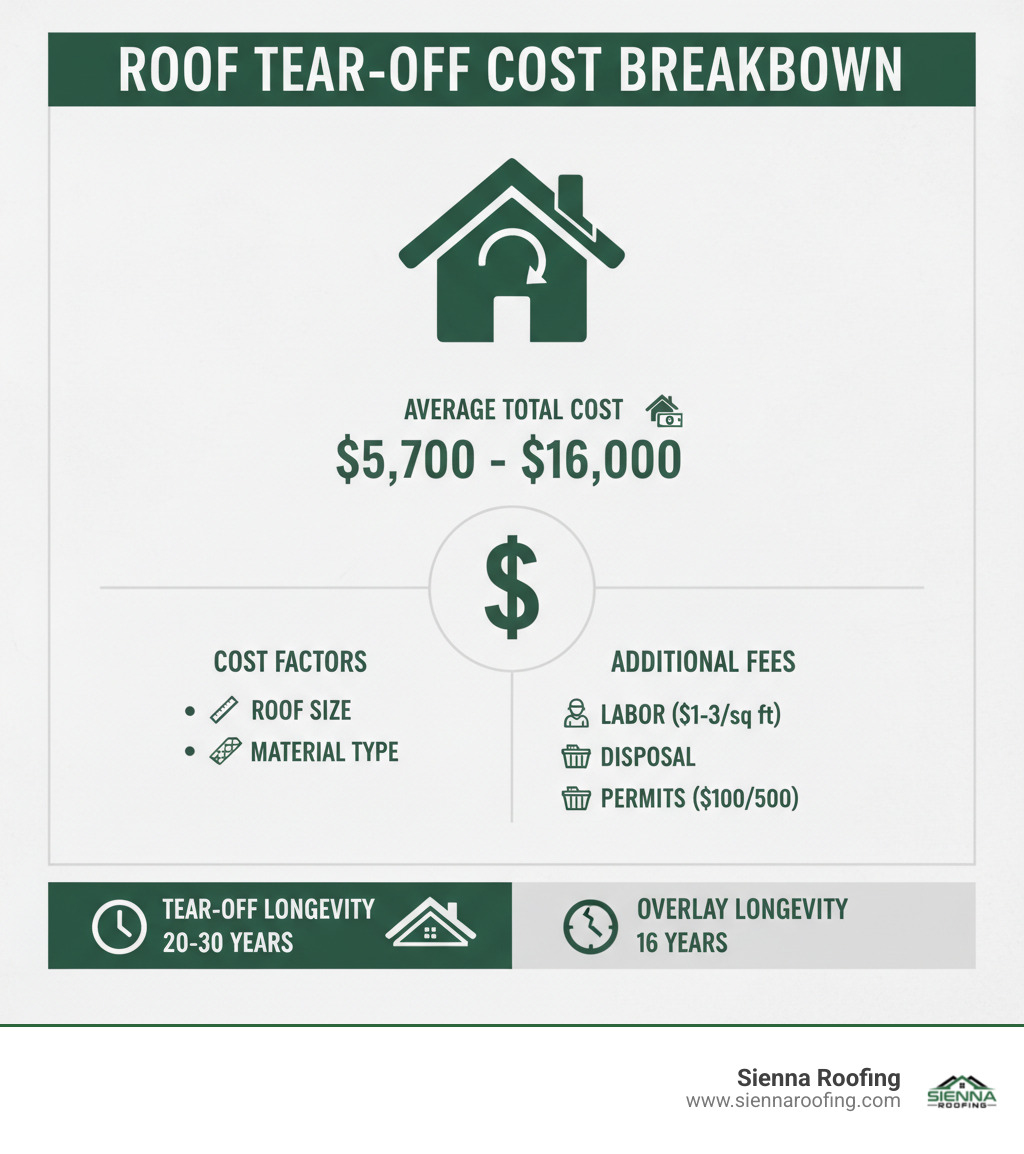
Must-know roof tear off cost terms:
What is a Roof Tear-Off and When is it Necessary?
When your roof has seen better days, you might hear two terms thrown around: “roof overlay” and “roof tear-off.” But what exactly is a roof tear-off, and why would you choose it over a seemingly simpler option?
A roof tear-off, also known as a complete roof replacement, involves removing all existing roofing materials down to the structural decking. This means taking off every shingle, tile, or metal panel, along with the underlayment beneath them. It’s like stripping your home down to its bare bones (roof-wise!) before rebuilding. This complete removal allows us to inspect the underlying decking and structure for any hidden damage, ensuring the new roof is built on a solid foundation.
In contrast, a roof overlay (or re-roof) involves installing new roofing materials directly over your existing ones. While this might sound appealing for its lower upfront cost and quicker installation, it comes with significant drawbacks, which we’ll explore in more detail later.
Choosing a tear-off is about ensuring the long-term health and structural integrity of your home. It’s often a necessary step for a truly durable and reliable roof replacement.
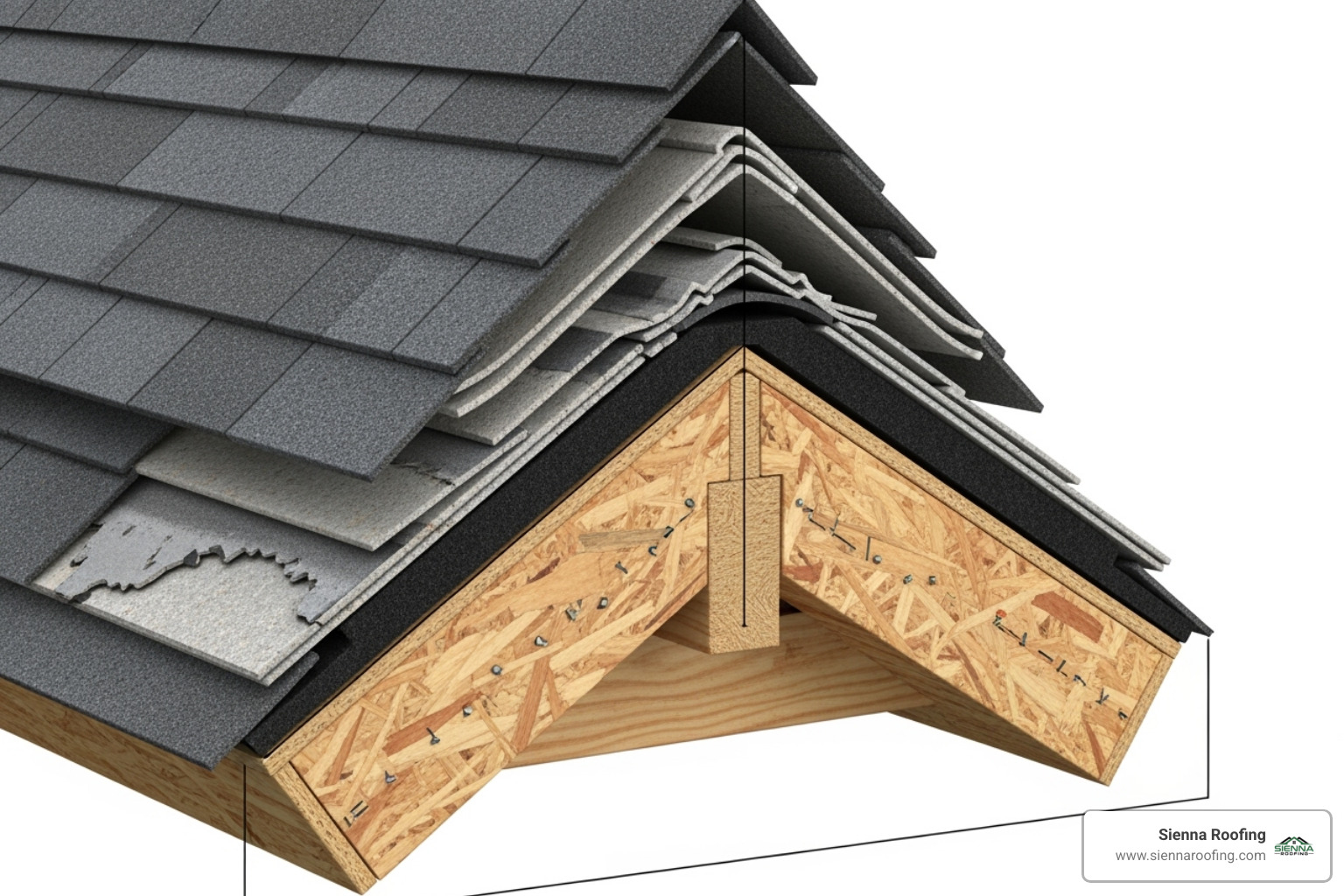
The Steps of a Roof Tear-Off and Replacement
A roof tear-off and replacement project is a multi-step process that requires careful planning and execution. Here’s a general overview of what you can expect when we undertake a project like this for your home:
- Property Protection: Before any work begins, our crew will take precautions to protect your home and landscaping. This includes laying tarps around the perimeter of your house to catch debris and safeguard shrubs, plants, and other delicate features.
- Shingle and Material Removal: This is where the “tear-off” comes in. Our team will carefully remove all existing layers of roofing material – be it asphalt shingles, tiles, or metal panels. This process requires skill and attention to detail to avoid damaging the underlying structure.
- Underlayment Removal: Once the top layers are off, the old underlayment (the protective layer beneath the shingles) is also removed.
- Decking Inspection and Repair: With the roof deck exposed, we conduct a thorough inspection for any signs of damage like rot, mold, or structural weakness. If we find any issues, such as damaged plywood or OSB, we’ll replace or repair these sections to ensure a sound base for your new roof. This step is crucial for the longevity of your new roof and is often missed in an overlay.
- New Underlayment Installation: A fresh layer of high-quality underlayment is installed. This provides an additional barrier against moisture and helps protect your home from leaks.
- New Shingle/Material Installation: This is the exciting part! Your chosen new roofing material is installed according to manufacturer specifications and local building codes. This includes meticulous attention to detail on flashing, ventilation, and other critical components.
- Flashing Replacement: All flashing around chimneys, vents, skylights, and other penetrations is replaced. New flashing is essential for preventing leaks in these vulnerable areas.
- Site Cleanup: Once the new roof is installed, our crew performs a comprehensive cleanup. This includes removing all debris from your yard, using magnetic brooms to pick up stray nails, and ensuring your property is left spotless. We believe a clean site is a happy site!
For more detailed information on our comprehensive approach, you can explore our roof replacement process.
5 Signs You Need a Full Tear-Off Instead of an Overlay
Deciding between a roof tear-off and an overlay isn’t always easy, but certain indicators make a full tear-off the clear choice. Here are five signs that your home definitely needs a complete tear-off:
- Existing Multiple Layers: Most building codes limit residential roofs to a maximum of two layers of roofing materials. If your home already has two layers, an overlay isn’t an option – a tear-off is mandatory. Attempting to add a third layer can put excessive stress on your home’s structure and may not pass inspection.
- Widespread Leaks or Water Damage: If your roof is experiencing widespread leaks, or if you’ve noticed water stains on your ceilings, visible mold growth, or soft spots in the roof deck, these are serious red flags. These issues indicate underlying problems that an overlay would simply cover up, allowing the damage to worsen. A tear-off allows us to expose and address the root cause of the water intrusion.
- Curling, Brittle, or Severely Damaged Shingles: While a few curling shingles might be repaired, widespread curling, brittleness, or significant granule loss across your roof indicates that the shingles have reached the end of their life. Curling can also signal water absorption or hot attic air damage, making your roof vulnerable. An overlay on top of severely damaged shingles will likely lead to premature failure of the new roof.
- Soft Spots on Decking or a Sagging Roofline: If you feel soft spots when walking on your roof, or if you can see a noticeable sag in the roofline, this points to compromised decking or structural issues. These problems cannot be fixed with an overlay and require a full tear-off to repair the underlying structure.
- Roof Age Over 20 Years with Significant Wear: For asphalt shingle roofs, if your roof is over 20 years old and showing significant signs of wear and tear, a tear-off is almost always recommended. Even if there are no obvious leaks, the materials are likely at the end of their functional lifespan, and an overlay would only provide a short-term fix. Additionally, if damage affects more than 25% of the roof’s surface, a full replacement is more cost-effective than extensive repairs.
Decoding the Average Roof Tear-Off Cost
When homeowners start researching their roofing project, the roof tear off cost can feel like a moving target. One estimate says one thing, another says something completely different. Let’s cut through the confusion and break down what you’re actually paying for.
The national average for a complete tear-off and replacement typically runs $5,700 to $16,000 for most homes. That’s a pretty wide range, right? The variation comes down to your specific situation – your roof size, the materials you choose, and your local labor rates all play a role.
Here’s how the math usually works out: you’ll pay $3 to $6 per square foot for the complete job, with the actual tear-off portion costing $1 to $3 per square foot. That tear-off cost covers the labor to remove everything and haul it away – which brings us to an expense many homeowners forget about.
Those old shingles have to go somewhere, and disposal isn’t free. Most projects need a 10- to 20-yard dumpster, which typically runs $220 to $699 per week depending on your location. The good news? Reputable contractors like Sienna Roofing include these costs upfront so there are no surprises.
| Roof Size (Square Feet) | Average Total Cost Range (Asphalt Shingles) |
|---|---|
| 1,200 sq ft | $3,600 – $7,200 |
| 1,700 sq ft | $5,100 – $10,200 |
| 2,500 sq ft | $7,500 – $15,000 |
| 3,000+ sq ft | $9,000 – $18,000+ |
These estimates are for asphalt shingles and can vary based on your specific project details and local market conditions.
How Material Choice Impacts Your Roof Tear-Off Cost
Your material choice is probably the biggest factor in your final roof tear off cost. Think of it like choosing between a Honda and a Mercedes – both will get you where you need to go, but the price tags tell very different stories.
Asphalt shingles remain the most popular choice for good reason. Basic 3-tab shingles run $3 to $5 per square foot for complete replacement, while architectural shingles bump that up to $4 to $6 per square foot. If you’re dreaming of luxury shingles, expect around $8.50 per square foot just for materials. Most homeowners end up spending $5,700 to $12,000 total for asphalt shingle projects.
Metal roofing offers incredible durability but comes with a higher price tag. Steel with exposed fasteners starts around $4.50 per square foot for materials, while standing seam steel jumps to $16 per square foot. Copper standing seam? That’s premium territory at $30 to $50 per square foot for materials alone. Total metal roof projects typically run $7,500 to $40,000.
Tile roofing brings that distinctive Mediterranean or Spanish look but requires more labor to remove and install. Clay, concrete, and terracotta tiles generally cost $7 to $25 per square foot, with total projects ranging $10,500 to $62,500. The extra weight means higher disposal costs too.
Slate roofing represents the premium end of the market. Natural slate runs $10 to $30 per square foot, with complete projects often hitting $22,000 to $70,000. The material is beautiful and lasts practically forever, but removing old slate requires specialized handling.
Cedar shake offers natural beauty at $7 to $15 per square foot, typically totaling $12,900 to $28,200 for most homes. The organic material requires careful removal to avoid damage to the underlying structure.
For Texas homeowners wanting local pricing insights, check out a deeper look at Texas roofing costs to see how these national averages translate to our market.
Uncovering Hidden Expenses: The True Roof Tear-Off Cost
Here’s where things get real about roof tear off cost – the extras that can catch you off guard if your contractor isn’t upfront about potential issues.
Decking replacement is the big one. When we strip off your old roof, we might find rotten or damaged plywood underneath. This isn’t anyone’s fault – it’s just what happens over time, especially in Texas weather. Replacing damaged decking adds $2 to $5 per square foot, and in severe cases, it can nearly double your project cost.
Structural repairs go deeper than decking. If water damage has reached your rafters or trusses, we’re looking at $5 to $14 per square foot for repairs, or $60 to $500 per truss just for materials. It sounds scary, but catching these problems now prevents much bigger headaches later.
Flashing replacement is standard in any quality tear-off, but complex rooflines with multiple valleys or dormers need more extensive work. Same goes for chimney work – we’ll inspect and re-seal everything while we’re up there, which might include re-pointing mortar or fixing chimney caps.
Skylight work often becomes necessary during tear-offs. Old skylights are leak magnets, so it’s the perfect time to re-flash or replace them entirely. Ventilation upgrades might also be recommended – proper airflow extends your new roof’s life and improves energy efficiency. These improvements typically run $200 to $700 but pay dividends long-term.
Don’t forget permit fees – most projects require them, and they typically run $100 to $500 depending on your local municipality. We handle all the paperwork to ensure your project meets building codes.
The key is working with a contractor who discusses these possibilities upfront. Nobody likes surprises, especially when they come with price tags attached.
Tear-Off vs. Overlay: A Cost and Longevity Comparison
When facing a roof replacement, you’ll encounter two main options: a complete tear-off or an overlay (sometimes called a re-roof). Think of it like renovating a house – you can either strip everything down to the bones and rebuild properly, or just put new wallpaper over the old. Both approaches will give your home a fresh look, but the similarities end there.
The choice between these methods affects everything from your upfront costs to your long-term value, and even your home’s structural safety and warranty coverage. Let’s explore the real differences so you can make the best decision for your home and budget.
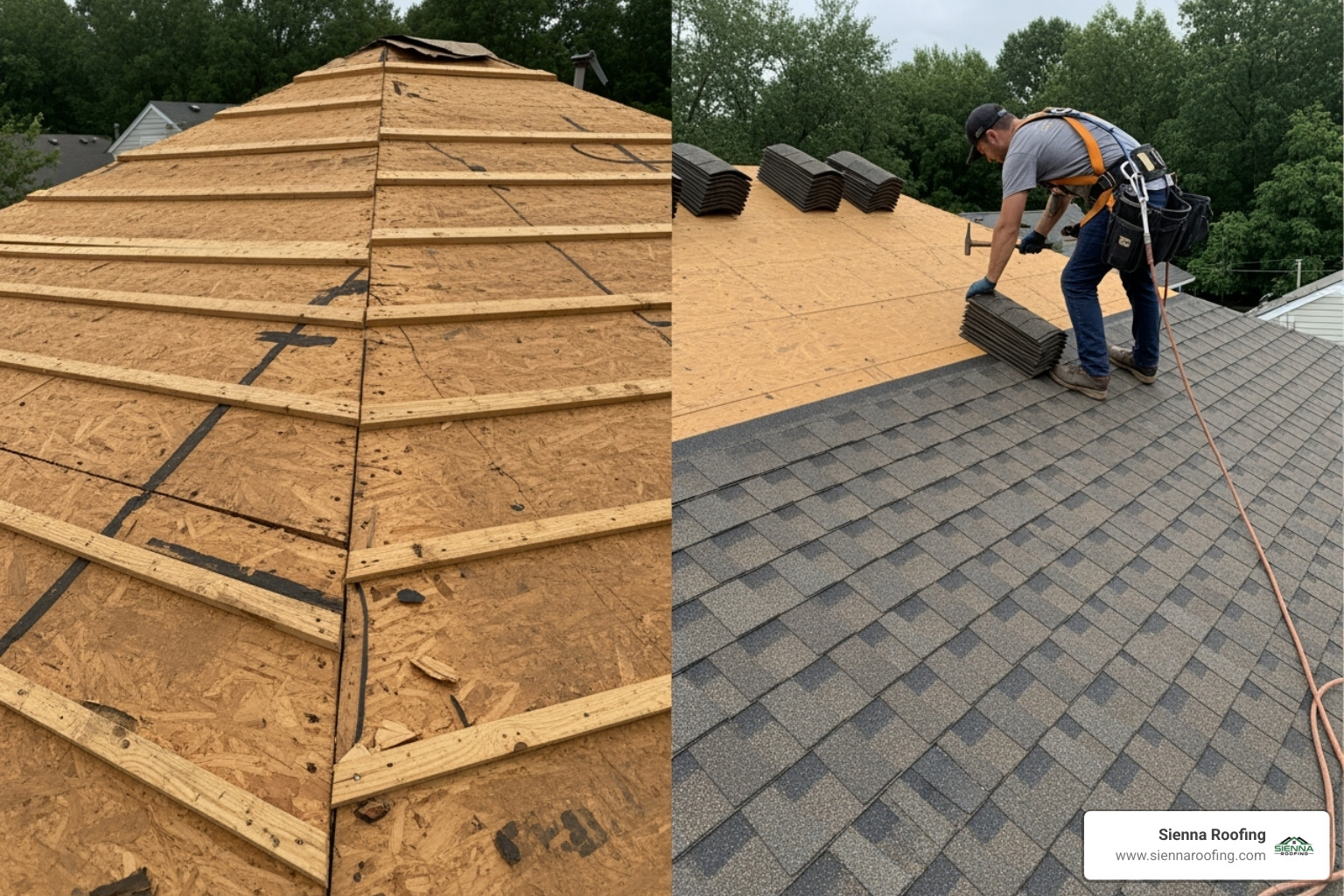
The Upfront Cost Difference
Here’s where overlays seem tempting – they typically cost about 25% less than a complete tear-off. For most homeowners, this translates to $1,000 or more in immediate savings. That’s real money that stays in your pocket, at least initially.
Why does an overlay cost less? The savings come from three main areas. No disposal fees means we’re not hauling away tons of old shingles or renting those big dumpsters you see in driveways. Reduced labor time is another factor – our crew isn’t spending days carefully removing old materials, which means fewer hours on your bill. Finally, faster project completion gets the job done about 25% quicker, minimizing disruption to your daily routine.
But here’s the thing about those upfront savings – they often come with hidden costs down the road. It’s like buying a used car that seems like a great deal until you start paying for repairs.
Long-Term Value, Lifespan, and ROI
This is where the math gets interesting, and honestly, where most homeowners realize a tear-off is the smarter investment.
A properly installed tear-off can protect your home for 20-30 years or even longer, depending on your material choice. An overlay typically lasts around 16 years – significantly shorter because those old layers underneath can trap moisture and accelerate deterioration.
The numbers get even more compelling when you consider resale value. A complete roof replacement can add $12,000 to $15,000 to your home’s value. According to the 2024 Cost vs. Value Report, roof replacements provide an average 60-70% return on investment. That means you’re not just spending money – you’re investing it.
There’s also the curb appeal factor. Your roof makes up about 40% of your home’s visible exterior, and a fresh, properly installed single layer looks dramatically better than new shingles laid over old, uneven ones.
Warranty and Structural Integrity
This might be the most important consideration, especially for long-term peace of mind.
Manufacturer warranties tell the whole story. Most roofing companies offer their best and longest warranties only for complete tear-offs. Choose an overlay, and you might find your warranty significantly reduced or even voided entirely. Manufacturers know they can’t guarantee their materials when installed over potentially compromised existing layers.
The hidden damage risk is what keeps us up at night as contractors. An overlay is like putting a band-aid over a wound without cleaning it first. Rotten decking, water damage, mold, or structural weaknesses remain hidden and continue to worsen. We’ve seen cases where homeowners paid for an overlay only to need a complete tear-off just a few years later – essentially paying twice.
Weight concerns are real too. An overlay doubles the load on your roof structure. While many homes can handle this, older homes or those in areas with heavy snow loads could face structural stress. Building codes limit homes to two layers maximum for good reason.
The EPA provides excellent moisture control guidance that explains why addressing underlying moisture issues is crucial for building integrity.
When we do a tear-off, we’re giving you a roof installed on a solid, inspected foundation with full manufacturer backing. That’s the kind of protection your home deserves.
Hiring the Right Contractor for Your Project
When it comes to managing your roof tear off cost effectively, choosing the right contractor can make or break your entire project. Think of it this way: you wouldn’t trust just anyone with your car’s engine, so why would you trust your home’s protection to an inexperienced team?
The stakes are particularly high for homeowners in Sugar Land, Missouri City, Richmond, and the greater Houston area, where intense summer heat and sudden storms test every roof. Finding a local contractor who truly understands these regional challenges isn’t just smart—it’s essential for getting the most value from your investment.
A reputable contractor brings more than just technical skills to your project. They understand local building codes, have established relationships with quality suppliers, and know how Texas weather affects different roofing materials. This expertise directly impacts your bottom line by preventing costly mistakes and ensuring your new roof performs as expected.
Project timelines also matter for your budget and peace of mind. A professional team typically completes a shingle roof tear-off and replacement in 1 to 3 days, while heavier materials like tile or slate require 6 to 8 days. Experienced contractors can accurately predict these timelines, helping you plan accordingly.
When evaluating potential contractors, local reputation should be your starting point. Companies with deep community ties have more at stake in maintaining their good name. Licensing and insurance aren’t optional—they’re your financial protection if something goes wrong. Always ask for written estimates that break down every cost, so you can compare apples to apples when making your decision.
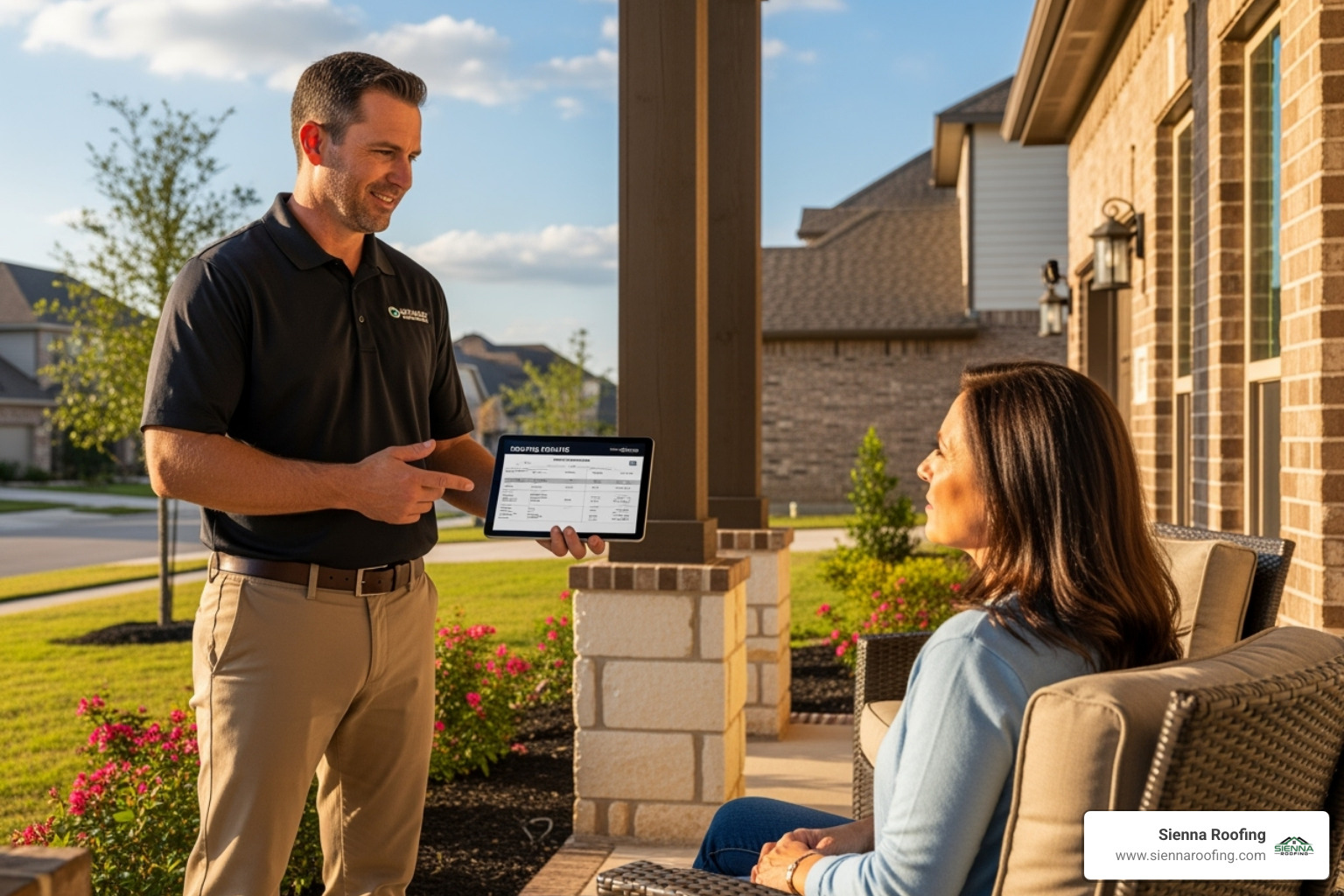
Questions to Ask Your Roofing Contractor
The right questions can save you thousands of dollars and weeks of headaches. Before you sign any contract, these conversations will reveal whether you’re dealing with true professionals or someone you should avoid.
“Are you licensed and insured in Texas?” This isn’t just a formality—it’s your financial safety net. A contractor without proper licensing can’t legally work on your home, and one without insurance leaves you liable for any accidents or damage.
“How long have you been in business?” Experience matters enormously in roofing. A company that’s weathered multiple economic cycles and seasonal challenges has proven they can handle complex tear-offs and unexpected problems that arise.
“Can you provide local references?” Nothing beats hearing from actual neighbors about their experience. A confident contractor will eagerly share recent project examples and customer contacts.
“Who will be on-site managing the project?” You want to know your point of contact for questions and concerns. The best companies assign a dedicated project manager who keeps you informed throughout the process.
“How do you handle debris disposal?” This directly affects your roof tear off cost and property safety. Professional teams should have a clear plan for managing and removing old materials without damaging your landscaping or leaving a mess.
“What does your warranty cover?” Understanding both labor and material warranties helps you evaluate the true long-term value. Some companies offer comprehensive coverage, while others provide minimal protection.
“What’s your process for unexpected issues like decking damage?” Honest contractors will explain how they handle surprises and get your approval before proceeding with additional work. This transparency prevents bill shock later.
These conversations help you gauge a contractor’s professionalism and commitment to quality work. For more guidance on making the right choice, check out our insights on finding trusted roofing companies in Sugar Land, TX.
Your Trusted Local Roofing Partner
For Houston area homeowners, working with a truly local company makes all the difference in your roofing experience. Sienna Roofing has built our reputation on transparent pricing, quality craftsmanship, and genuine care for our community.
We understand that discussing roof tear off cost can feel overwhelming, which is why we take time to explain every detail of your project. Our team doesn’t just show up, do the work, and disappear—we’re your neighbors, and we’ll be here when you need us down the road.
Name: Sienna Roofing
Address: 17034 University Blvd, Sugar Land, TX 77479
Phone: (832) 564-3322
Your Roof is an Investment, Not an Expense
Understanding the roof tear off cost is about making a smart, long-term investment in your home’s safety and value. While the initial expense of $5,700 to $16,000 is significant, it buys decades of security. A full tear-off is a comprehensive solution that addresses hidden issues an overlay would only conceal, preventing costly future repairs.
Your roof protects everything underneath it. Choosing a complete tear-off means you’re investing in a solid foundation, full manufacturer warranties, and improved curb appeal. With a potential ROI of 60-70% and a significant boost to your home’s resale value, the numbers confirm that a new roof is one of the wisest improvements you can make.
Ready to take the next step toward lasting peace of mind? Getting a clear picture of your project costs doesn’t have to be overwhelming. Contact our team at Sienna Roofing for a comprehensive roof replacement estimate. We provide transparent pricing and honest advice to ensure your roof replacement is a stress-free investment in your home’s future.
